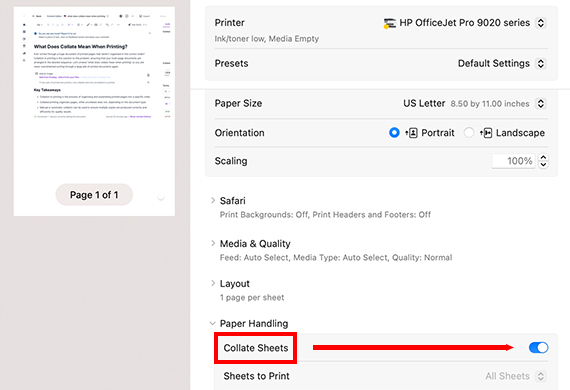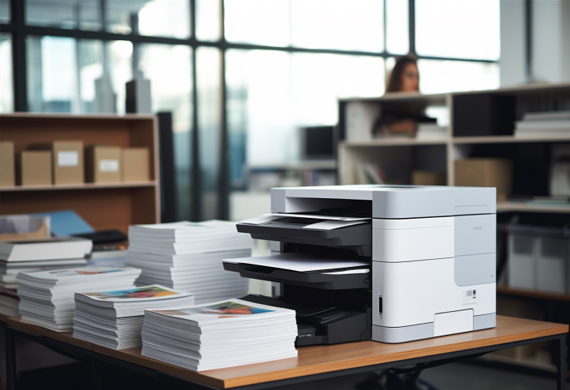What Does Collate Mean When Printing?
Posted by Clash Printing Atlanta on 30th Nov 2023
Ever sorted through a huge document of printed pages that weren't organized in the correct order? Collation in printing is the solution to this problem, ensuring that your multi-page documents are arranged in the desired sequence. Let's unravel “what does collate mean when printing” so you do not unnecessarily find yourself sorting through a large pile of printed documents ever again.

Key Takeaways
Collation in printing is the process of organizing and assembling printed pages into a specific order.
Collated printing organizes pages, while uncollated does not, depending on the document type.
Manual or automatic collation can be used to ensure multiple copies are produced correctly and efficiently for quality results.
Understanding Collation in Printing
Collation in printing refers to the process of organizing and assembling printed pages in a specific order, commonly used for multi-page documents like books, catalogs, and magazines. When you print collated copies, the printer prints multiple pages in the correct sequence. This is particularly relevant in the printing industry, where efficiency and productivity are key for large-scale projects.
But what does collate mean when printing multiple copies of a document? Simply put, collated printing ensures that all the pages of a document are in their proper order, from the first page to the last, before moving on to the next copy of the document, manual, book, or booklet. This is especially useful for complex documents consisting of multiple sheets, as it eliminates manual sorting and organizing.
A comprehensive knowledge of the printing process is instrumental for effectively managing printing projects. Understanding when to opt for collated or uncollated printing can greatly influence efficiency and productivity. As we further examine collation, you'll identify critical differences between collated and uncollated printing and learn how to select the most suitable method for your project.
Collated vs. Uncollated: The Key Differences
When you compare collated versus uncollated printing, the core difference lies in the organization of the printed pages. Collated printing arranges pages in a specific order, whereas uncollated printing does not adhere to any particular sequence. This difference is significant when dealing with multi-page documents requiring a logical order for straightforward reading and understanding.
Uncollated printing is suitable for single-page documents or materials that don't require multiple copies in a specific order, such as flyers, posters, brochures, or single-page letters. In such cases, collation is unnecessary, and you can print uncollated copies without worrying about the sequence. To turn off collating, toggle the setting off in the print settings or print preview.

Conversely, collated printing is necessary for documents like:
books
catalogs
manuals
booklets
These documents demand a certain sequence for readability and a professional look. By choosing the right method for your printing project, you can ensure that your documents are organized in the correct order and are ready for binding or distribution.
The Collation Process: How It Works
The collation process can be executed either manually or automatically via software or printer settings, which arrange and print pages in the right order. Depending on the complexity of your printing project and the capabilities of your printer, you can choose the most suitable method for your needs.
The two primary methods of collating are manual collation and automatic collation. Let's examine the specifics of each method and consider their strengths and weaknesses.
Manual Collation
Manual collation involves physically sorting and organizing printed pages in the correct order, often used for small-scale projects or when dealing with multiple versions of a document. This method offers significant accuracy and control, ensuring that every document copy is organized in the intended sequence.

The step-by-step procedure for manual collation includes the following:
Printing multiple copies
Arranging the pages in the correct order
Grouping the pages into sets
Repeating the process for multiple sets if necessary
Verifying the order
Binding or stapling the sets together
Although manual collation can be laborious, particularly for large print jobs, it offers flexibility and precision.
To manually collate your documents, you'll need:
Printed pages
A flat surface or table
Paper clips or binder clips
A pen or marker
Optionally, a collating machine or software
With the right tools and patience, manual collation can ensure your documents are organized accurately and professionally.
Automatic Collation
Automatic collation leverages software or printer settings to sort and print pages in the right order, maximizing time efficiency and minimizing error risks. Modern printers come equipped with features that enable automatic collation, ensuring that multiple copies of a multi-page document are printed correctly from the first to the last.
To activate automatic collation, select the “collate” option in your printer settings or print preview. Being fast, efficient, and economical, this method is a great fit for large-scale printing projects. Employing automatic collation, you can guarantee the uniform quality of your printed documents while optimizing time and resources.
Practical Applications of Collated Printing
Collated printing is used in various practical applications, such as:
reports
booklets
instruction manuals
other multi-page documents that require a specific order for readability and professionalism

Opting for collated printing for these projects, you can guarantee that your documents are well-ordered and primed for distribution.
For example, when printing a report that includes an introduction, executive summary, and multiple sections, collated printing ensures that each section is printed in the correct order and that no pages are missing or duplicated. This not only makes the printing process more efficient but also ensures that the final product is precise and of exceptional quality.
Collated printing refers to the process that is essential for projects involving printing multiple copies of a document, such as conference materials or training manuals. When you need to print multiple copies, printing collated copies allows you to economize time and effort in arranging the printed pages, guaranteeing that each attendee receives a comprehensive and properly sequenced set of materials.
Benefits of Collated Printing
Collated printing brings multiple benefits, including:
Cost efficiency
Enhanced quality and consistency
Expedited production time
User-friendliness
Automating the collation process negates manual sorting, leading to time and resource savings ultimately lowering printing costs.
Moreover, collated printing offers several benefits:
All pages are printed in the right order, without any missing or duplicate pages.
This assures that the printed documents maintain superior quality and consistency.
It is significant in preserving a professional image and delivering accurate information to your audience.
The ease and simplicity of using collation in printing machines also add to the overall advantages of collated printing. By selecting the appropriate print settings, you can easily group collated documents together, allowing for faster production times and eliminating the need for manual binding or fastening.
Troubleshooting Common Collation Issues
While collation can be applied to both single-sided and double-sided printing, guaranteeing correct document formatting is necessary to prevent any issues during the printing process. To ensure that your documents are formatted correctly, ensure the paper used is of suitable quality and is loaded correctly in the printer with no tilt.
If you encounter any collation issues during the printing process, double-check your printer settings and ensure that the collate option is enabled or disabled, depending on your project requirements. Additionally, verify that your printer software is up-to-date and compatible with your operating system to avoid potential compatibility issues.
Finally, if you're encountering collation issues or have a large-scale printing project needing professional assistance, consider collaborating with a reputable printing shop that offers collate printing services. They can help you ensure accurate and efficient collation and provide valuable guidance on the best printing practices for your specific project.
Tips for Successful Collated Printing Projects
For successful collated printing projects, adhere to these recommended practices:
Accurate document preparation
Unambiguous print settings
Quality control
Experimentation to ascertain the most effective approach
By adhering to these guidelines, you can ensure that your printed documents are organized, accurate, and ready for distribution when you need to print documents.

When handling large-scale printing projects, follow these steps for better control and accuracy:
Segment the task into manageable parts.
Arrange pages in smaller groups.
Verify the print settings and quality to ensure the correct printing of your collated pages without any errors.
Finally, consider partnering with a professional printing shop that provides collating services for your print document, especially for substantial or intricate projects. Their expertise and specialized equipment can guarantee accurate and efficient collation, ensuring that your printed documents are of the highest quality and professionalism.
Summary
In conclusion, understanding the concept of collation in printing is essential for managing multi-page printing projects effectively. Collated printing organizes pages in a specific order, ensuring that your documents are accurately arranged and ready for distribution. By choosing the right method for your printing project, whether it's manual or automatic collation, you can save time, reduce errors, and achieve professional results.
Collated printing has numerous practical applications, such as reports, booklets, and instruction manuals, which require a specific order for readability and professionalism. By embracing the benefits of collated printing, you can streamline the printing process, improve the quality and consistency of your documents, and enhance your overall productivity.
So, the next time you embark on a printing project that requires multiple copies of a multi-page document, remember the importance of collation and the benefits it offers. Armed with this knowledge, you'll be well-equipped to tackle any printing challenge with confidence and precision.
Frequently Asked Questions
Should I collate when printing?
Collation is essential when printing multiple copies of a multi-page document to keep the pages in the correct order. It's important for the accuracy and professionalism of your printed materials.
What happens if I don't collate?
Without collating, the printer will print pages in an undesired order, resulting in having to rearrange the individual pages by hand. With collating, the printer prints each copy of the document in the correct order, saving you time and effort.
What is collated vs uncollated?
Collated documents are organized in a sequence, whereas uncollated ones consist of separate sets of pages. When printing multiple copies of a document, collated printing produces complete documents, with each copy including all pages in the correct order.
Is collated the same as double-sided?
No, collation and double-sided printing are not the same thing. Utilizing the 'collate' function ensures that all pages are printed in the intended sequence, irrespective of whether the document is printed on one side or both sides.
What are some practical applications of collated printing?
Collated printing has a number of practical applications, such as for reports, booklets, and instruction manuals, allowing documents to be printed in a specific order quickly and efficiently.
(678) 235-3464







